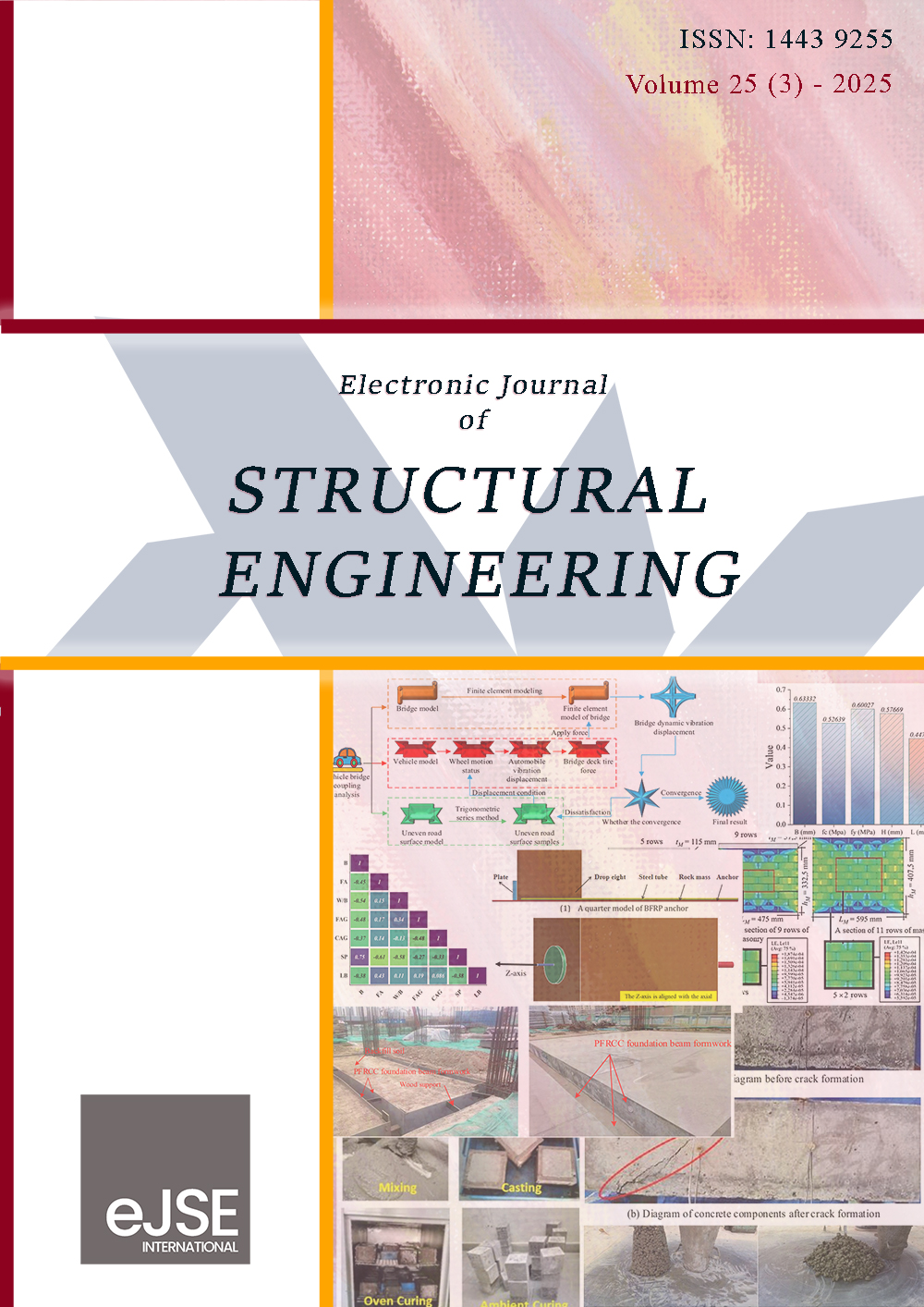Optimization of Mixing Proportions to Improve Strength and Hydraulic Performance in Pervious Concrete
DOI:
https://doi.org/10.56748/ejse.24804Keywords:
Optimum Mix Design, Pervious Concrete, Aggregate Cement Ratio (A/C), Porosity, Water PermeabilityAbstract
The ever-increasing desire in pervious concrete is fuelled by its eco benefits, especially in eco water administration and city drainage systems. However, optimizing its mechanical durability while preserving suitable penetrability and porosity remains a crucial obstacle. This study examines the influence of mix proportions on the structural and water performance of previous concrete to distinguish a perfect mix design. Fifteen mix versions were assessed by changing the water-to-cement (W/C) ratio, aggregate-to-cement (A/C) ratio, and cement content. The conclusions show that a mix containing 440 kg/m3 of cement with a W/C ratio of 0.32 accomplished the largest compressive strength of 22 MPa while preserving operational penetrability. The findings propose that an ideal balance between mechanical and water properties can be accomplished through precise material proportioning and controlled compaction energy. These understandings provide a foundation for designing high-functioning previous concrete, making it a viable solution for eco infrastructure applications.
Downloads
References
ACI-522. (2010). Report on pervious concrete. In. Farmington Hills, MI: American Concrete Institute.
Al-Luhybi, A. S., Al-Jubory, N. H., & Ahmed, A. S. (2022). Influence of Superplasticizer Dosage on Workability and Mechanical properties of Concrete made with Recycled Aggregate. Journal of Engineering & Technological Sciences, 54(5).
Al-Luhybi, A. S., & Qader, D. N. (2021). Mechanical properties of concrete with recycled plastic waste. Civil Environ Eng, 17(2), 629-643.
Al-Sulayvani, B. J., & Al-Talabani, D. N. (2015). Strengthening and repairing circular RC slabs with openings using CFRP strips under repeated loading. Construction and Building Materials, 84, 73-83.
Ali, M. K., Kareem, Q., Ahmad, S., Shawkat, I. A., & Kassim, M. (2023). Compressive and Flexural Strength of High-Volume Fly Ash Mortars Aged with Air-entraining Admixtures. E3S Web of Conferences,
ASTM-C39/C39M. (2012). Standard Test Method for Compressive Strength of Cylindrical Concrete Specimens. In Annual Book of ASTM Standards (pp. 7).
ASTM-C143/C143M. (2003). Standard Test Method for Slump of Hydraulic-Cement Concrete. In Annual Book of ASTM Standards (pp. 4).
ASTM-C1754/C1754M. (2012). Standard Test Method for Density and Void Content of Hardened Pervious Concrete. In Annual Book of ASTM Standards (pp. 3).
B., R. (2024). Experimental study on mechanical properties of modified pervious concrete as a rigid pavement for low volume traffic. International Journal of Scientific Research in Engineering and Management, 8(5), 1-5.
Bury, M. A., Mawby, C.A., and Fisher, D. . (2006). Making Pervious Concrete Placement Easy: Using a Novel Admixture System. Concrete in Focus 55-59.
Crouch, L., Cates, M. A., Dotson Jr, V. J., Honeycutt, K. R., & Badoe, D. A. (2003). Measuring the effective air void content of Portland cement pervious pavements. Cement, concrete, and aggregates, 25(1), 1-5.
Güneyisi, E., Gesoğlu, M., Kareem, Q., & İpek, S. (2016). Effect of different substitutions of natural aggregate by recycled aggregate on performance characteristics of pervious concrete. Materials and Structures, 49, 521-536.
Haselbach, L. M., & Freeman, R. M. (2006). Vertical porosity distributions in pervious concrete pavement. ACI materials journal, 103(6), 452.
Ibrahim, I., Shakor, P., Nasih, D., & Al-Luhybi, A. S. (2024). A comprehensive review of recent experimental and numerical investigations on the impact of openings in steel plate shear walls (SPSWs). Passer Journal of Basic and Applied Sciences, 6(2), 275-285.
Kevern J.T., S. V. R., Wang K., and Suleiman M.T. (2008). Pervious concrete mixture proportions for improved freeze-thaw durability. Journal of ASTM International, 5(2).
Kumar, B. S., & Srikanth, K. (2023). A study on properties of pervious concrete with high-volume usage of supplementary cementitious materials as substitutes for cement. Asian journal of civil engineering, 24(7), 1997-2009.
Lim, E., Tan, K. H., & Fwa, T. F. (2013). Effect of mix proportions on strength and permeability of pervious concrete for use in pavement. Journal of the Eastern Asia Society for Transportation Studies, 10, 1565-1575.
McCain, G. N., & Dewoolkar, M. M. (2010). Porous concrete pavements: mechanical and hydraulic properties. Transportation research record, 2164(1), 66-75.
NeithAlAth, N., Bentz, D. P., & Sumanasooriya, M. S. (2010). Predicting the permeability of pervious concrete. Concrete international, 32(5), 35-40.
Neithalath, N., Deo, O., and Sumanasooriya, M.S. (2013). Computational Material Science Based Predictive Tools for the Performance of Pervious Concrete ProQuest LLC.
Neithalath, N., Weiss, J., & Olek, J. (2006). Characterizing enhanced porosity concrete using electrical impedance to predict acoustic and hydraulic performance. Cement and concrete research, 36(11), 2074-2085.
Qader, D. N., Sirwan, R., & Ali, M. K. (2024). Impact of composite and aluminium face sheets on the properties of the 3D-printed cores under quasi-static three-point bending. Electronic Journal of Structural Engineering, 24(1), 12-15.
Sahdeo, S. K., Ransinchung, G., Rahul, K., & Debbarma, S. (2020). Effect of mix proportion on the structural and functional properties of pervious concrete paving mixtures. Construction and Building Materials, 255, 119260.
Schaefer, V. R., & Wang, K. (2006). Mix design development for pervious concrete in cold weather climates.
Tennis, P. D., Leming, M. L., & Akers, D. J. (2004). Pervious concrete pavements (Vol. 8). Portland Cement Association Skokie, IL.
Tong, B. (2011). Clogging effects of portland cement pervious concrete.
Tyner, J., Wright, W., & Dobbs, P. (2009). Increasing exfiltration from pervious concrete and temperature monitoring. Journal of Environmental Management, 90(8), 2636-2641.
Wang, K., Schaefer, V., Kevern, J., & Suleiman, M. (2006). Development of mix proportions for functional and durable pervious concrete. NRMCA concrete technology forum: focus on pervious concrete,
Yang, J., & Jiang, G. (2003). Experimental study on properties of pervious concrete pavement materials. Cement and concrete research, 33(3), 381-386.
Yang, Z. (2011). Freezing-and-thawing durability of pervious concrete under simulated field conditions. Materials Journal, 108(2), 187-195.
Downloads
Published
How to Cite
Issue
Section
License
Copyright (c) 2025 Mohammed Kamal Ali, Qays Kareem, Omeed Adwal A. Ali, Diyar N. QADER

This work is licensed under a Creative Commons Attribution 4.0 International License.







